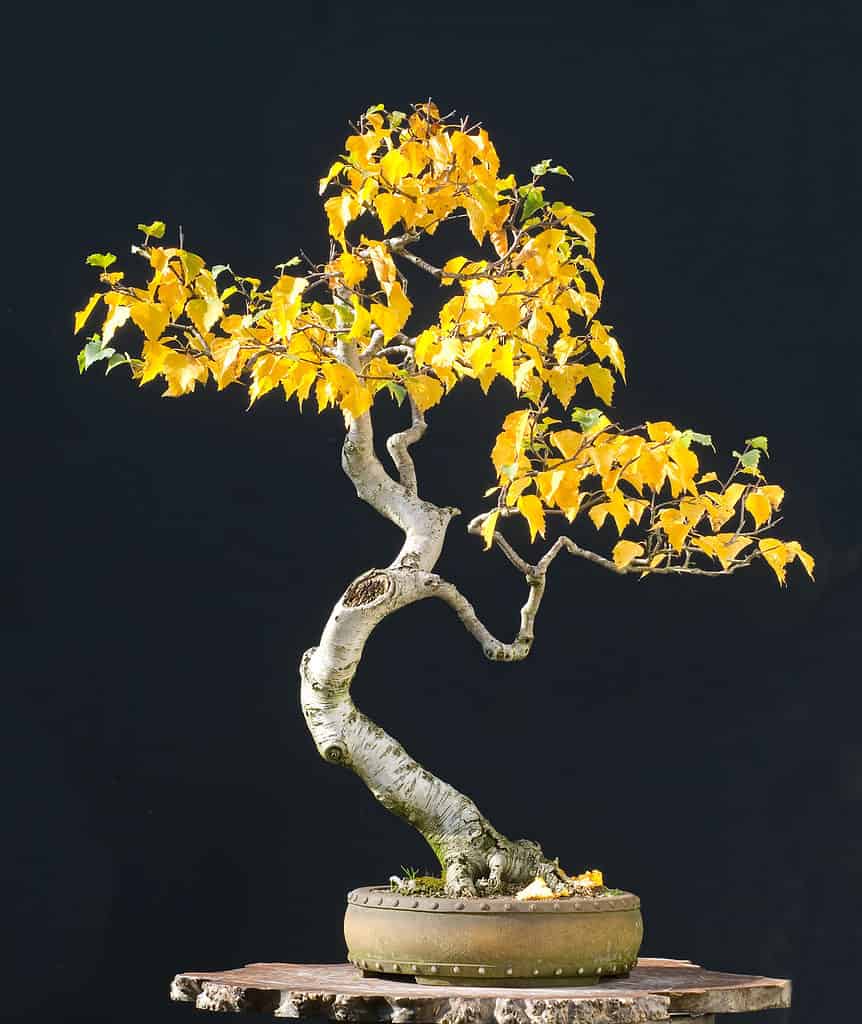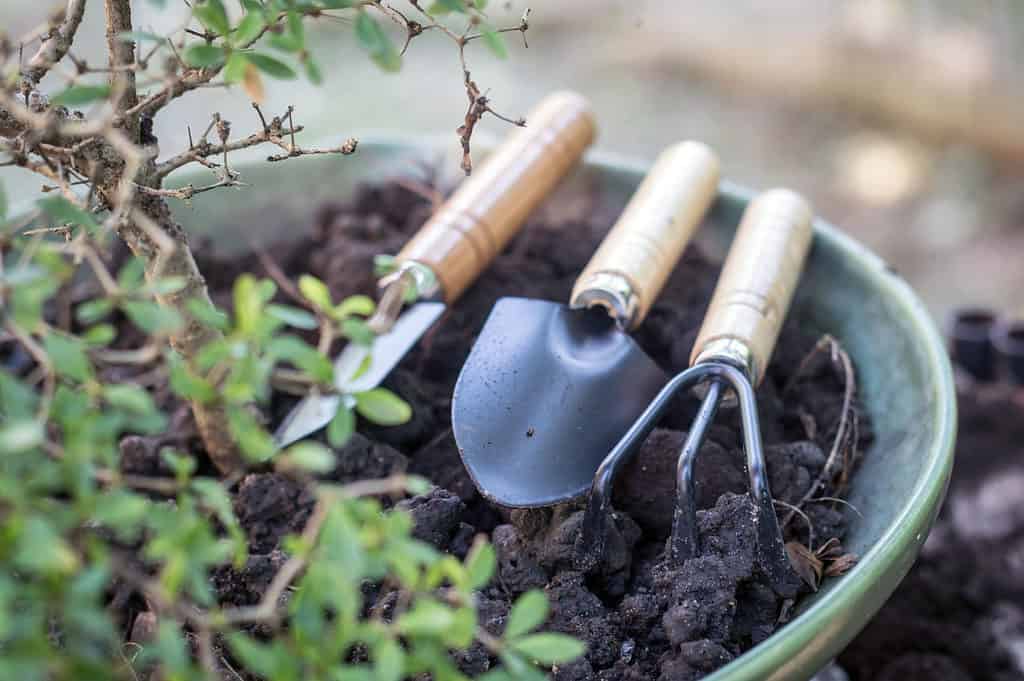Birch Bonsai trees are a popular choice for Bonsai trees because they are relatively low maintenance and produce beautiful results. What are the different types of birch Bonsai trees, and how do you take care of them?
Here is everything you need to know about caring for a birch Bonsai tree!

Deciduous in nature, birch Bonsai trees change colors with the seasons.
©Walter Pall/Shutterstock.com
| Birch Bonsai Tree Facts | |
|---|---|
| Botanical Name | Betula |
| Common Types | bog birch, river birch, cherry birch, dwarf birch, silver birch, Japanese white birch, water birch, yellow birch |
| Sunlight | Full sun to partial shade |
| Soil | Depends on the specific type of birch tree, but most birch trees can thrive in a variety of soil conditions. Regular Bonsai tree soil mixture will suit them well. |
| Water | Consistently moist, but well-drained. In the summer, these trees need a regular watering schedule. |
| For Beginners? | Beginner to intermediate. As a whole, they are relatively low maintenance. They take well to pruning, though be careful to not take too much from the tree at once. |
| Indoors or Outdoors? | Indoors and outdoors |
| Pairs Well With… | Moss, rocks, and other natural ornamentation. |
Common Types of Birch Bonsai Trees

One of the most widely cultivated birch trees, sweet birches produce ample amounts of wintergreen oil.
©Kyle Selcer/Shutterstock.com
Birch trees can be found all over the world. It is this widespread adaptability that makes them a great choice to be grown as Bonsai trees. Most varieties of birch trees are suited to Bonsai tree art!
Here are the most common types of birch Bonsai trees!
Bog Birch
Bog birches are native to North America. They look more like shrubs than trees, as their branches form clumps. They do best in wet, damp environments and grow at a moderate rate. Bog birch is known to prefer full sun and can tolerate different types of soil. They do best in wet, alkaline soil, however.
River Birch
River birch trees are native to certain areas of the United States. These trees either grow as a single trunk tree or as a multi-trunk tree. It looks as if they form clumps when they grow. Out of all of the birch trees, river birch is one of the few that is actually resistant to heat and warm temperatures. They prefer full sun to partial shade and can do well in just about all types of soil.
Cherry Birch
Cherry birch trees, when planted naturally, are massive trees. The bark shines a red-brown color, from which the name comes, while the leaves are yellow. They flower during late spring which gives way to catkins in early fall. These trees prefer full sun to partial shade. They thrive best in moist, acidic soil that is well-drained. They especially like sandy or rocky loam.
Dwarf Birch
Dwarf birch trees are native to cold regions like Greenland and Iceland, as well as northern Europe, Asia, and North America. However, they have been known to grow in a wide variety of environments. They appear more shrub-like than tree-like, and in the wild can grow up to about 10 feet. They prefer well-drained, acidic soil and full sun.
Silver Birch

The European silver birch Bonsai tree is well-suited for four-season weather.
©Walter Pall/Shutterstock.com
Silver birch trees are native to Europe and Asia. They are known for their white-colored bark, from which their name comes. They prefer full sun and moist, well-drained loam, especially if it is sandy. In late spring, these trees begin to flower. These blooms give way to catkins that appear yellow-brown in color.
Japanese White Birch
The Japanese white birch is native to eastern Asia, specifically Japan, Korea, and China. These trees are also known for their white-colored bark. They prefer full sun though they can grow in partial shade. As for soil, they do best in wet but well-drained rocky or sandy loam. Japanese white birch trees thrive in cooler environments as opposed to warm or hot places.
Water Birch
Water birch trees are native to western North America. These trees can usually be found along streams and rivers, especially in areas that are mountainous. The bark on these birch trees ranges from red-brown to even black, and it doesn’t peel, unlike other birch trees. They prefer full sun to partial shade and moist, sandy loam.
Yellow Birch
Yellow birch trees are native to northeastern North America. They have been named for the color of their bark. It ranges from yellow to bronze. These trees, when planted naturally, often grow bigger than most other birch trees. They prefer full sun to partial shade and moist, wet soil
Caring for Your Birch Bonsai Tree

The intricate bark of most birch tree species makes for a beautiful Bonsai tree.
©Sergey Bezgodov/Shutterstock.com
For the most part, taking care of a regular birch tree is relatively easy. This care process does not change much when growing a birch tree as a Bonsai tree. There are some things to be aware of, however, to ensure that your birch Bonsai tree goes properly. We’ll go into detail down below, from sunlight to soil type, water to placing your birch Bonsai tree.
Sunlight
As a whole, most birch trees prefer full sun. Though there are some that tolerate partial shade, and very few that actually thrive in shady conditions.
Soil Type
For the most part, a large number of birch trees seem to tolerate different kinds of soil. Many birch trees do best in soil that is well-draining, though. Bonsai trees require special soil mixtures to help them grow properly, and your birch Bonsai tree should benefit from these mixtures, too. They are designed to be well-draining.
Water
Birch Bonsai trees need to be watered often, especially in the summer when temperatures are hot. Take care to not overwater your birch Bonsai tree during these months. In the winter, the soil only needs to be slightly moist.
Placement
As a whole, most birch trees love the sunshine and should be placed accordingly, so they can get the most of it throughout the day. However, if they are exposed to the sun too much in the summer, their leaves can burn. When it starts to get hot, make sure to protect your birch Bonsai tree from the midafternoon sun, if you can.
Pruning Your Birch Bonsai Tree

There are a number of birch species well-suited for Bonsai cultivation.
©Christian Musat/Shutterstock.com
Birch Bonsai trees react well to cutting and pruning. But if you do too much at once or take away large pieces at a time, you can inadvertently give your birch Bonsai tree wood rot. Wood rot can lead to a hollow trunk.
Wiring is important if you plan on styling your birch Bonsai tree in a hanging fashion. However, you will need to be careful as it is easy for the frailer, weaker branches to die if they are wired.
Ideal Birch Bonsai Tree Styles
Since birch Bonsai trees have thick trunks, the most popular style for these trees is Chokkan. This is also known as the upright style. Another easy style for birch Bonsai trees is Sokan, the double trunk style. Shakan style can also be easily achieved with a birch Bonsai tree.
Propagating Your Birch Bonsai Tree

Your Bonsai tree may need certain tools for repotting and transplanting.
©wonderisland/Shutterstock.com
For the most part, it is easy to propagate a birch Bonsai tree from cuttings as well as seeds. They seem to grow from seeds easier than cuttings, though. For cuttings, you can use semi-hardwood cuttings that are less than five inches in length. Plant them as you would any other Bonsai tree propagation!
Common Problems with Birch Bonsai Trees
As a whole, birch trees are hardy but they are still susceptible to pests, insects, and disease. For instance, aphids and the larvae of sawflies have been known to harm birch trees. Thankfully, you can easily get rid of these pests with insecticide. Birch rust can also be a problem, but this is also easily solved with a specific type of fungicide.
The photo featured at the top of this post is © Christian Musat/Shutterstock.com
Thank you for reading! Have some feedback for us? Contact the AZ Animals editorial team.






